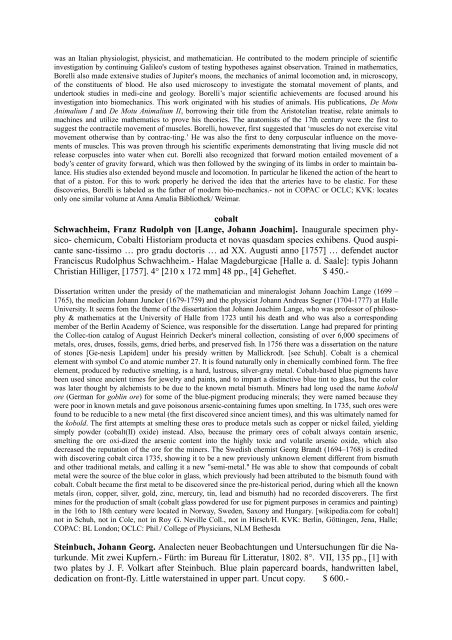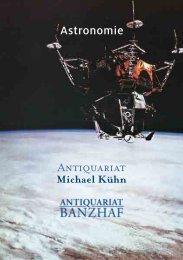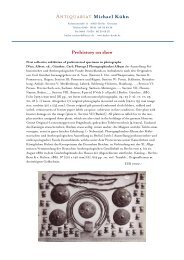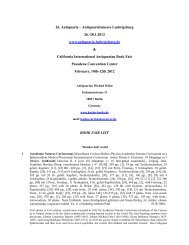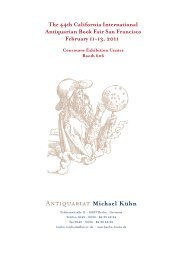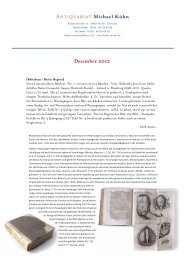List New York Antiquarian Book Fair - Antiquariat - Michael Kühn
List New York Antiquarian Book Fair - Antiquariat - Michael Kühn
List New York Antiquarian Book Fair - Antiquariat - Michael Kühn
Create successful ePaper yourself
Turn your PDF publications into a flip-book with our unique Google optimized e-Paper software.
was an Italian physiologist, physicist, and mathematician. He contributed to the modern principle of scientific<br />
investigation by continuing Galileo's custom of testing hypotheses against observation. Trained in mathematics,<br />
Borelli also made extensive studies of Jupiter's moons, the mechanics of animal locomotion and, in microscopy,<br />
of the constituents of blood. He also used microscopy to investigate the stomatal movement of plants, and<br />
undertook studies in medi-cine and geology. Borelli’s major scientific achievements are focused around his<br />
investigation into biomechanics. This work originated with his studies of animals. His publications, De Motu<br />
Animalium I and De Motu Animalium II, borrowing their title from the Aristotelian treatise, relate animals to<br />
machines and utilize mathematics to prove his theories. The anatomists of the 17th century were the first to<br />
suggest the contractile movement of muscles. Borelli, however, first suggested that ‘muscles do not exercise vital<br />
movement otherwise than by contrac-ting.’ He was also the first to deny corpuscular influence on the movements<br />
of muscles. This was proven through his scientific experiments demonstrating that living muscle did not<br />
release corpuscles into water when cut. Borelli also recognized that forward motion entailed movement of a<br />
body’s center of gravity forward, which was then followed by the swinging of its limbs in order to maintain balance.<br />
His studies also extended beyond muscle and locomotion. In particular he likened the action of the heart to<br />
that of a piston. For this to work properly he derived the idea that the arteries have to be elastic. For these<br />
discoveries, Borelli is labeled as the father of modern bio-mechanics.- not in COPAC or OCLC; KVK: locates<br />
only one similar volume at Anna Amalia Bibliothek/ Weimar.<br />
cobalt<br />
Schwachheim, Franz Rudolph von [Lange, Johann Joachim]. Inaugurale specimen physico-<br />
chemicum, Cobalti Historiam producta et novas quasdam species exhibens. Quod auspicante<br />
sanc-tissimo … pro gradu doctoris … ad XX. Augusti anno [1757] … defendet auctor<br />
Franciscus Rudolphus Schwachheim.- Halae Magdeburgicae [Halle a. d. Saale]: typis Johann<br />
Christian Hilliger, [1757]. 4° [210 x 172 mm] 48 pp., [4] Geheftet. $ 450.-<br />
Dissertation written under the presidy of the mathematician and mineralogist Johann Joachim Lange (1699 –<br />
1765), the medician Johann Juncker (1679-1759) and the physicist Johann Andreas Segner (1704-1777) at Halle<br />
University. It seems fom the theme of the dissertation that Johann Joachim Lange, who was professor of philosophy<br />
& mathematics at the University of Halle from 1723 until his death and who was also a corresponding<br />
member of the Berlin Academy of Science, was responsible for the dissertation. Lange had prepared for printing<br />
the Collec-tion catalog of August Heinrich Decker's mineral collection, consisting of over 6,000 specimens of<br />
metals, ores, druses, fossils, gems, dried herbs, and preserved fish. In 1756 there was a dissertation on the nature<br />
of stones [Ge-nesis Lapidem] under his presidy written by Mallickrodt. [see Schuh]. Cobalt is a chemical<br />
element with symbol Co and atomic number 27. It is found naturally only in chemically combined form. The free<br />
element, produced by reductive smelting, is a hard, lustrous, silver-gray metal. Cobalt-based blue pigments have<br />
been used since ancient times for jewelry and paints, and to impart a distinctive blue tint to glass, but the color<br />
was later thought by alchemists to be due to the known metal bismuth. Miners had long used the name kobold<br />
ore (German for goblin ore) for some of the blue-pigment producing minerals; they were named because they<br />
were poor in known metals and gave poisonous arsenic-containing fumes upon smelting. In 1735, such ores were<br />
found to be reducible to a new metal (the first discovered since ancient times), and this was ultimately named for<br />
the kobold. The first attempts at smelting these ores to produce metals such as copper or nickel failed, yielding<br />
simply powder (cobalt(II) oxide) instead. Also, because the primary ores of cobalt always contain arsenic,<br />
smelting the ore oxi-dized the arsenic content into the highly toxic and volatile arsenic oxide, which also<br />
decreased the reputation of the ore for the miners. The Swedish chemist Georg Brandt (1694–1768) is credited<br />
with discovering cobalt circa 1735, showing it to be a new previously unknown element different from bismuth<br />
and other traditional metals, and calling it a new "semi-metal." He was able to show that compounds of cobalt<br />
metal were the source of the blue color in glass, which previously had been attributed to the bismuth found with<br />
cobalt. Cobalt became the first metal to be discovered since the pre-historical period, during which all the known<br />
metals (iron, copper, silver, gold, zinc, mercury, tin, lead and bismuth) had no recorded discoverers. The first<br />
mines for the production of smalt (cobalt glass powdered for use for pigment purposes in ceramics and painting)<br />
in the 16th to 18th century were located in Norway, Sweden, Saxony and Hungary. [wikipedia.com for cobalt]<br />
not in Schuh, not in Cole, not in Roy G. Neville Coll., not in Hirsch/H. KVK: Berlin, Göttingen, Jena, Halle;<br />
COPAC: BL London; OCLC: Phil./ College of Physicians, NLM Bethesda<br />
Steinbuch, Johann Georg. Analecten neuer Beobachtungen und Untersuchungen für die Naturkunde.<br />
Mit zwei Kupfern.- Fürth: im Bureau für Litteratur, 1802. 8°. VII, 135 pp., [1] with<br />
two plates by J. F. Volkart after Steinbuch. Blue plain papercard boards, handwritten label,<br />
dedication on front-fly. Little waterstained in upper part. Uncut copy. $ 600.-


